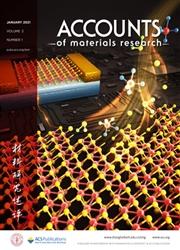Nanospace Engineering of Metal–Organic Frameworks for Adsorptive Gas Separation
IF 14.7
Q1 CHEMISTRY, MULTIDISCIPLINARY
引用次数: 0
Abstract
Gas separation is a critical process in the industrial production of chemicals, polymers, plastics, and fuels, which traditionally rely on energy-intensive cryogenic distillation techniques. In contrast, adsorptive separation using porous materials has emerged as a promising alternative, presenting substantial potential for energy savings and improved operational efficiency. Among these materials, metal–organic frameworks (MOFs) have garnered considerable attention due to their unique structural and functional characteristics. MOFs are a class of crystalline porous materials constructed from inorganic metal ions or clusters connected by organic linkers through strong coordination bonds. Their precisely engineered architectures create well-defined nanoscale spaces capable of selectively trapping guest molecules. In contrast to traditional porous materials such as zeolites and activated carbons, emerging MOFs not only demonstrate exceptional capabilities for pore regulation and interior modification through nanospace engineering but also hold great promise as a superior platform for the development of high-performance functional materials. By virtue of the isoreticular principle and building unit assembly strategies in MOF chemistry, precise adjustments to pore structures─including pore size, shape, and surface chemistry─can be readily achieved, making them well-suited for addressing the separation of intractable industrial gas mixtures, particularly those with similar sizes and physicochemical properties.

金属-有机骨架吸附气体分离的纳米空间工程
气体分离是化工、聚合物、塑料和燃料工业生产中的一个关键过程,传统上依赖于能源密集型的低温蒸馏技术。相比之下,使用多孔材料的吸附分离已成为一种有前途的替代方法,具有节约能源和提高操作效率的巨大潜力。在这些材料中,金属有机骨架(MOFs)因其独特的结构和功能特性而受到广泛关注。mof是一类由无机金属离子或金属簇通过强配位键连接的有机连接剂构成的晶体多孔材料。他们精确设计的结构创造了定义良好的纳米级空间,能够选择性地捕获客体分子。与传统的多孔材料(如沸石和活性炭)相比,新兴的mof不仅表现出通过纳米空间工程进行孔隙调节和内部修饰的卓越能力,而且作为高性能功能材料开发的优越平台,前景广阔。凭借MOF化学中的等正交原理和构建单元组装策略,可以很容易地实现对孔隙结构(包括孔隙大小、形状和表面化学)的精确调整,使它们非常适合于解决难处理的工业气体混合物的分离,特别是那些具有相似大小和物理化学性质的气体混合物。
本文章由计算机程序翻译,如有差异,请以英文原文为准。
求助全文
约1分钟内获得全文
求助全文

 求助内容:
求助内容: 应助结果提醒方式:
应助结果提醒方式:


